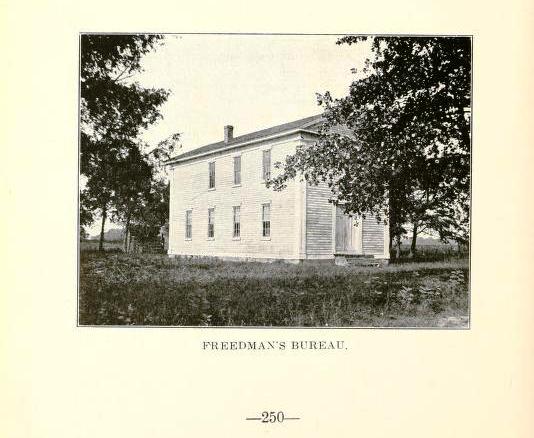The History of Caroline County, Maryland, From Its Beginning
Denton (Pig Point, Edenton)
Garey's Oaks, Willoughby's, Andersontown
Lidens, Hickman, Williston, Williamson's
The Bureau

DENTON
Denton, for more than a century the county seat of Caroline County, on the east border of the Choptank, was originally named, "Edenton," in honor of Sir Robert Eden, proprietary Governor of Maryland in 1769-1774. The "e" was dropped, thus changing Edenton to "Denton" a little while subsequent to the Revolution and Governor Eden's departure for England.
The county seat, which at the time was at Melvill’s Warehouse, a mile and half farther up the river, was removed to Denton in the early nineties; a square of land containing four acres having been purchased for the erection of a court house and jail in October 1791. The price paid was “thirty shillings, current money, per acre.” The old map on record in the office of the Clerk of the Circuit Court, an interesting showing of the work of that days, bears the signature of Robert Orrell, surveyor, and those of three of the five village commissioners—Levin Charles, Alex. Maxwell and Solomon Brown. The village as shown by the map numbered forty-nine buildings in all. It was then a village of some commercial importance as is evidenced by “shop,” “store,” “wharf” and “granary” marked on the map.
In November 1792 it was enacted by the General Assembly of Maryland, “That Joseph Richardson, Christopher Driver, William Robinson, Henry Downes and Robert Hardcastle have full power and authority to open and lay off a road, and make a good and sufficient causeway, through the marsh on the east side of Choptank river, opposite, or as nearly opposite the court house of said county as they may think best or proper, and erect a wharf at the end of said causeway, if they shall think it necessary.”
In 1796 William Richardson, William Potter, George Martin, Henry Downes, Christopher Driver, Joshua Driver and John Bennett were appointed commissioners to attend to surveying Denton.
The act providing for the surveying follows:“WHEREAS it is represented to this General Assembly, that the owners of the land contiguous to Denton, in Caroline County, are desirous that a village should be surveyed and laid out, with convenient streets, lanes and alleys; therefore, BE IT ENACTED, That the said commissioners, or a majority of them, are hereby authorized and empowered, with the consent of the proprietor or proprietors aforesaid, to survey and lay out any quantity of land not exceeding fifty acres, including the public square called Denton in Caroline County, and the lands thereto contiguous and the same, when surveyed, to be erected into a village, and to be called and known by the name of Denton; and such village, when surveyed and laid out, to divide into lots, which lots shall be numbered and bounded by stones, at every corner of the same; and the said commissioners, or a majority of them, are hereby authorized and empowered to survey and lay out a sufficient number of streets, not exceeding fifty feet wide, as also a sufficient number of alleys, not exceeding twenty feet wide, through the said village, for the public convenience;…”At the same time provision for relaying the public square was made in the following act:“WHEREAS it is represented to this General Assembly, that the public square of Denton might be much more advantageously located, by exchanging a part of said public square for a small quantity of land lying on the south side thereof, by means whereof a communication with the main street, leading through Denton, will be formed with the said public square, which was originally laid out anew the public square, which was originally laid out and condemned in pursuance of the act of assembly to which this is an additional supplement; and in case the said commissioners or a majority of them, shall deem it most advantageous to the public, they, or a majority of them, are hereby authorized and empowered to exchange a part of the said public square lying on the northernmost side thereof, not exceeding one acre, for the like quantity of land on the southernmost side of the said square and upon the proprietor or proprietors of any such land so exchanged executing a deed or deeds of bargain and sale, agreeably to the laws of this state, such land shall be forever thereafter deemed and taken to be part of the said public square, and as such to be used and enjoyed.”
THE OLD MARKET PLACENearly a century ago, there was erected on the southeast corner of the public square facing Market Street, where the Masonic Hall now stands, an open building about thirty feet long, which was used as a market place. Across the pillars which supported the roof extended boards for shelves. Some green produce; eggs, and meat, including beef by the quarter and whole pigs as well as smaller quantities, were brought here and either sold from these shelves or the wagons which were backed up there for that purpose. Here also slaves may have been sold.
The following comes under the date of 1827:
"Whereas the commissioners of the village of Denton have erected on the public ground in said village a market house, and Whereas the members of Washington Lodge No. 59, of Free and Accepted Mason, have erected over said market house a room or rooms to be occupied as a Lodge room or rooms, Therefore"BE IT ENACTED, by the General Assembly of Maryland, That James Sangston, John Brown, Nehemiah Fountain, Bennett Wherrett and James Hand, the commissioners of the village of Denton, and their successors, or a majority of them, shall for ever hereafter hold, possess and enjoy, all the public ground on which said market house and Lodge house and Market street, and also all the public ground between said market house and Lodge house and Second street, and twenty feet of public ground immediately contiguous to the west side and north end of said market house; Provided that nothing in this act shall be construed so as to authorized the said commissioners or their successors or the officers of Washington Lodge to erect thereon any other public buildings for the use, convenience and benefit of said village.
AND BE IT ENACTED, That the members of Washington Lodge No. 59, and their successors, shall for ever hereafter hold, possess and enjoy, the said room or rooms erected by them over the said market house, in as full and ample a manner as if they had an actual deed for the premises on which it is erected, without any let, hindrance or molestation, of any person whatsoever; and in case at any time the said Lodge shall go down, the commissioners of the village of Denton shall have it in their power to rent the room or rooms now occupied as a lodge room or rooms, and apply the proceeds to the payment and costs of the subscribers for the erection of the rooms now occupied as a Lodge after keeping up all necessary repairs, any thing in any law to the contrary notwithstanding."BANKS In December 1813 a number of citizens of Caroline County prayed that a bank be established in Denton. The acts regarding the same are given below:
"BE IT ENACTED, by the General Assembly of Maryland, That a bank to be called and known by the name of The Bank of Caroline shall be established in the village of Denton, in Caroline County."
"AND BE IT ENACTED, That the capital stock of this bank shall consist of two hundred thousand dollars, money of the United States, divided into eight thousand shares of twenty-five dollars each."
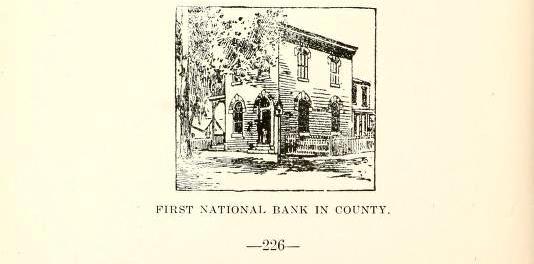
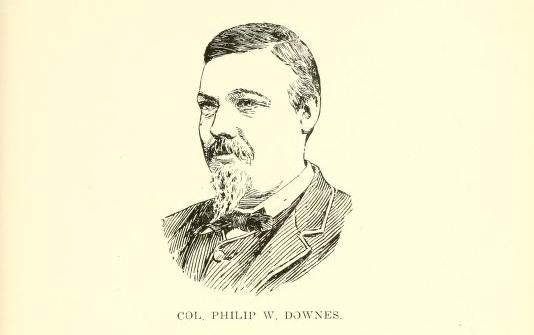
The People's Bank which became a State Bank in 1919 was organized in 1898, with a capital stock of $50,000 as a National Bank, with Joseph H. Bernard as president and George Wallace as cashier, and transacted business for a number of years in the Masonic Building. Later, the present bank was built at a cost of $20,000. Mr. Bernard procured some Indiana limestone, saved from the Baltimore Fire, as the building material. Henry T. Nuttle of Andersontown, is now president and T. F. Johnson is cashier.
The youngest bank of Denton is the Farmer's and Merchants State Bank, which was organized in 1919 with John T. Carter as first president and Sherman Hignutt as cashier. It is located on Main and Third Streets in the Carter Building. Its Capital Stock is $30,000. The Board of Directors are pleased with the business they are transacting and it promises to become a strong banking institution.
FIRST FACTORY
Perhaps the first factory built in Denton, was the old plow factory, located on the northeast corner of Main and Fourth Streets and erected about 1835. Henry Wilson, father of the late Charles Wilson, an eccentric old gentleman, but highly esteemed by Caroline Countians, was proprietor. The factory produced complete plows for many years, one of which is still owned by Mr. C. H. Stewart. After the death of the owner, the manufacture of plows was discontinued and after much wear the walls finally decayed. Many of the residents of Denton recall the happy hours of their childhood when "coming home from school they looked in at the open door" and wondered at the sights and sounds of the first factory they had ever seen.
LEADING MERCHANTS IN 1820
In 1820, according to the diary kept by the late Jefferson Pratt, Sangston and Hardcastle were the leading merchants of Denton. They bought tan-bark, wood, grain, dried fruit, feathers, wool, poultry and other country produce, which they shipped to the city by sail vessels. In this year corn sold at twenty-five cents a bushel and wheat from sixty to eighty cents.
OLD COINS USED LONG AGO
During the early days of Caroline County the coins that were in general use were very different from those that we use today. At that time they had the twelve and one-half cent piece which was called a "levy," the six and one-fourth cent piece which was called a "fip," the three cent piece, and the two cent piece. In some sections of the county the levy was called a "bit" and even today in some localities we hear of the quarter dollar being called "two bits."
EARLY TRAVEL ACROSS THE CHOPTANK AT DENTON
It has not always been as easy and convenient for the people of this
community to travel across the Choptank River as it is now. In the
early days their only way of getting across here was by means of small
boats or ferry which perhaps landed near what is now the jail, then
called Pig Point.
About 1792, probably in order to
shorten the distance of the ferry across here, there was a causeway laid
through the marsh on the east side of the river. This causeway was
very low at first and was often covered with water. Later it was
raised and traveling across it was much easier. Many of our old
residents remember a few occasions when they had to be rowed to the top
of the hill in boats.
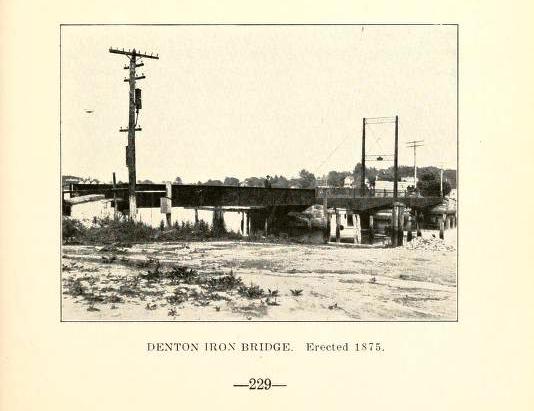
A few years later in 1811, a number of citizens on seeing how much more
convenient it would be to have a bridge here, decided to form a company
to erect one, so they were incorporated by the General Assembly under
the name of "The President and Directors of the Denton Bridge
Company."
This first bridge was a narrow one
way drawbridge with a draw twenty-six feet long and a toll bridge to all
persons not residents of Caroline County. The Levy Court paid a
small sum ($280) each year to allow these to go over free. Those
who came here from other counties had to pay twenty-five cents for a
four wheeled vehicle; twelve and one half cents for a two-wheeled
vehicle; six and a fourth cents for a horse and rider; three cents for
each mule or horse, and two cents for each foot passenger. In 1818
this toll was doubled.
This bridge remained a toll bridge
until shortly before the Civil War, when it was sold to the county and
in about 1875 replaced by the iron bridge which remained standing until
1913 when the concrete bridge was constructed.
OLD STAGE ROUTES
The old stage coaches which ran between Denton and various points, long
before the railroads were built in Caroline County, are well remembered
by a few of our citizens. They were large substantial vehicles
usually drawn by two horses and carried both mail and passengers.
Traveling in these old coaches was
very slow and tiresome, although the rate of speed depended, to a
certain extent, on the condition of the roads and the weather.
Sometime before 1860 there was a
stage line started between Easton and Felton, Del. via Denton.
After 1860 the stage met the Chester River boat at Queenstown. It
usually left here between six and seven o'clock in the morning and was
due in Queenstown anywhere between ten and twelve o'clock. If the
tide happened to be low it was necessary for the passengers to be
carried out in a row boat or a scow before they would get aboard the
steamer which was then anchored out some distance from the shore.
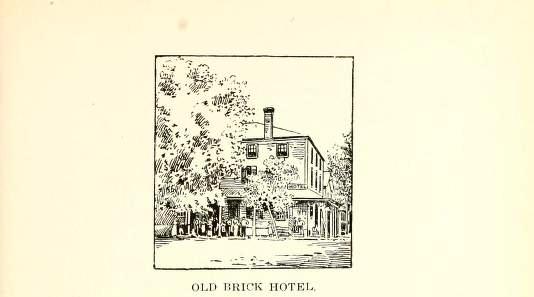
OUR FIRST STEAMBOATS
The first steamboat came up the Choptank River to Denton from Baltimore
before 1850. It was named the "Cyrus." People gathered here
from miles around, or on their own shores, to see it as it passed.
There was talk among the very small boys and also the negroes that the
waves would probably wash them away from the shore. So when the
darkies saw it coming they all ran and hid and none could be seen
anywhere.
"The Cyrus" perhaps only made one
trip, but a little later "The Dupont" with Captain Case as captain made
weekly trips between Denton and Baltimore. Instead of having
wheels on the side, as "The Cyrus" had, and as most of the boats of
today have, it was propelled by one wheel from the back. If there
were any passengers on this boat coming down to visit a home on the
river shore, where the wharf was not deep enough for the steamer to
dock, the captain would sometimes have the small boats lowered and send
them ashore.
AN OLD GRAVE
One of the oldest graves that can be identified in this vicinity is that of Major John Young in the old cemetery at the rear of the Methodist Church. In some places the brick wall which was built around it, has fallen. The marble slab, though much worn and modeled, still shows the following inscription:
to the memory
Major James Young
who was born the 14th day of June 1775,
and died January 1822,
aged forty eight years and seven months.
The blow, how sudden, how
severe the dart,
This marble shows life's fleeting scene.
Proclaims it but a passing dream
While time rolls on, while moments fly,
This stone cries out, 'Prepare to die.'
Friends, be not careless concerning your duty to God, for time is on
the wing. Heaven is worth striving for.
Philosophy, age, and experience tell us there is no real pleasure in
this world, our hopes and pursuits of such end with disappointments,
with this a strong influence that reason is loudly proclaiming to the
universe, there is a world beyond this where a Heaven of enjoyment is
awaiting the Righteous."
This Major Young was a Caroline Countian by birth and at one time a banker of Denton. He was also a member of the State Legislature and a Major in the War of 1812. One of his sons, Captain Edward Young, was for many years a commander of a boat on Maryland waters and was widely known on the Eastern Shore.
A UNION SHIP VISITS DENTON
In the early years of the Civil War a Union cutter came to Denton and
anchored at the bridge. This ship brought about fifty men
commanded by Captain Numbers, whose purpose was to
arrest and punish any Southern sympathizers that had spoken too freely
of their own opinions. Some of these were: Messrs.
Thomas H. Slaughter, Ezekiel Saulsbury, Eben Wright, Josiah Beck, Silas
Christopher, W.P. Stafford, and Frank
Porter.
Number's men had been directed to the
Slaughter residence. Upon nearing it, they saw a horseman riding
rapidly toward them. As soon as the rider discovered the presence
of the officers he rode about fifty yards to the edge of a swamp and
escaped to Hickory Ridge where Wesley Smith fed
him till it was safe for him to return and prepare to join the
Confederate Army. Later on the soldiers tried to capture David
Wright, father of the late Mr. Wright of
Andersontown, also a Southern sympathizer. They compelled Mr.
Hobbs, then a neighbor of Mr. Wright to
lead them to the house of the suspect but upon their arrival they found
that Mr. Wright had escaped.
The soldiers left Denton about
forty-eight hours after their arrival, without a single prisoner, but
they had thoroughly scared all the Southern sympathizers.
AN UNFORTUNATE CELEBRATION
A company of Union soldiers was stationed at Denton, as guards in 1863,
and in celebrating the Fourth of July brought quite a disaster upon the
town they were supposed to benefit.
They had been celebrating with the
use of skyrockets and other explosives used on the Fourth of July, and
it was some of these that started the fire. At the back of Mr.
Blackiston's store, where Mr. William
Bullock has a garage, was a rum shop. While the
lower part of the building was used as a rum shop, the second floor was
used as a store room for flax and cotton. Some of the rockets
landed on the roof which started the flax burning. This being a
late hour, and the town being unprepared to fight fire, it burned about
all the business part of the town, which consisted of several stores, a
hotel, and this rum shop.
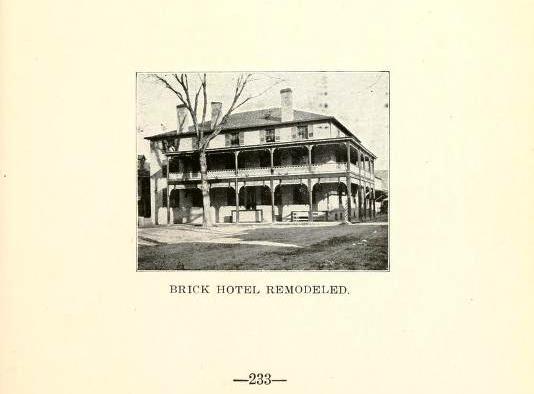
OLD GRIST MILL
In the summer of 1868 a grist mill was built in Denton on the north end
of the present Fourth Street on what was known as Saulsbury creek.
The joint owners of the mill were, Mr. John Emerson,
father of the late Mr. Waldo Emerson, and Mr.
Frederick Roschy, a German shoemaker of Denton. Mr.
Emerson, however, managed the business and had his office on the
site of Mr.Frederick Towers' present home.
This mill was run by power but the first heavy storm that came washed
the dam out. At once a new dam was built and a race led back to
the turbine wheel which operated the mill.
Further trouble with the power led
the owners to discontinue the milling business. Mr.
Philip Downes later bought the building and moved it to
Towers' Wharf where it now stands.
STREET LIGHTING
After the streets of Denton had for many years been lighted by oil lamps faithfully attended by Charles Smith, now janitor of the Court House, in 1901 the people were very much pleased with the gas plant which was built for the purpose of lighting streets and homes. But a few years later, as the electric light plant had been started near Denton, the gas plant was discontinued and electricity substituted.
LAW BUILDING
In 1902, "The Law Building and Realty Co." was incorporated by W. H. Deweese, H. L. Cooper, A. G. Towers and Fred R. Owens and the same year the Law Building was built on Main Street, opposite the Court House, on the site of the old Choptank Hotel. The lower floor is now used for the Post Office, hardware store, and other offices; the second floor, for law offices only; and the third floor for lodge rooms and a Law Library.
THE PAVING OF MAIN STREET
When Denton's Main Street was paved in 1915 and 1916, as the result of a
law passed by the General Assembly the year before, a decided
improvement was made to the town. The work done by Mr.
C. S. Kauffman, representative of the Holt Construction Co., is made
of concrete, about seven inches in thickness, with a six inch curb on
either side. The extent of this road is about seven-eighths of a
mile, extending from the railroad in East Denton to the foot of Denton
Hill, including the causeway and making a total length of a mile and a
quarter. The width of the street varies from sixty feet in front
of the Law Building, to thirty feet through the main part of the town to
Eighth Street, east of which point it is only fourteen feet in width.
The cost of construction ws about
$22,000, the state paying for one half of the cost, if twenty-four feet
in width or less, and if over twenty-four feet in width paying for
twelve feet only, the town meeting the cost of the remainder. The
individual property owners paid for the construction of the curb, the
cost of which was one dollar per running foot.
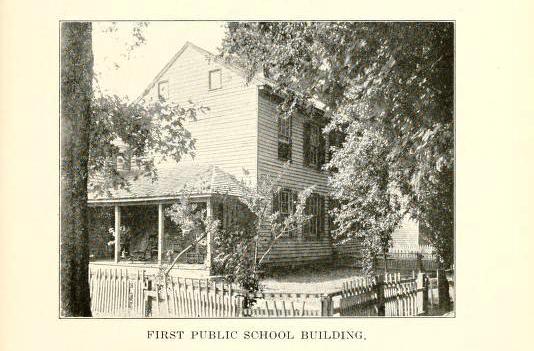
SCHOOLS
Records of the General Assembly of 1804 show that the parcel of land in Denton now used for a jail was once set apart for the purpose of building thereon a school house, but owing to difficulty in securing funds nothing was done for several years. From year to year however, effort was made to get an Academy in Denton, until at last in 1826 the General Assembly made it possible to proceed by paying two hundred and fifty dollars for the purpose and an equal amount yearly for its support. This Academy was conducted in the Hall, over the old Market House, on the site of the present Masonic Hall.
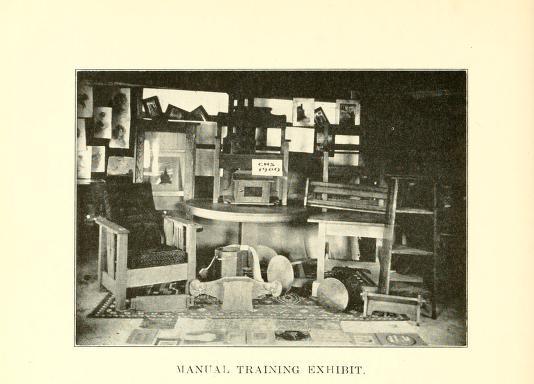
The year 1887 stands out in school history, for the County School Commissioners, authorized the first High School in the County. Prof. Chas. W. Bryn was the first principal of this school, which was conducted in the Masonic Hall for two years.
Feeling the need of a new school building, in 1901 the present High School was erected on Franklin Street. It is an attractive and comfortable building and for some years was large enough for every need. In the last few years, however, the attendance upon the town schools has grown so rapidly that the building is entirely inadequate.
CHURCHES
Methodist Episcopal
The history of the Methodist Episcopal church in Denton began apparently
with Moore's Chapel in 1816, as given in this volume under the
heading--Early Churches.
The present brick church was erected
in 1867, Rev. John Hough being pastor
at that time. Several years ago this church was thoroughly
repaired, remodeled and a Sunday School room added.
Presbyterian
One of the first churches built in Denton was the Presbyterian church which was situated on what is now Gay St. Although no one seems to know just when it was built, services were discontinued here many years before the Civil War. After this time it was sold to the colored people and is now supposed to form a part of the M. E. Church of this place.
Methodist Protestant
Many years ago an effort was made to establish a society of the M. P. Church in Denton, but it was deferred until the spring of 1897. On Monday night, April 26th, of that year, Rev. H. W. D. Johnson, Rev. W. J. D. Lucas, Rev. C. E. Dryden, and several members held a meeting in the school house and decided to rent a hall and have regular service. Accordingly Downes Hall was engaged, chairs and church literature purchased and on Sunday, May 2nd, the first services were held by Rev. Mr. Johnson preaching. On Sunday, May 9th, Rev. C. E. Dryden organized a Christian Endeavor Society. On Sunday, May 23rd, a Sunday School was instituted, Mr. T. Pliny Fisher being chosen Superintendent. On Nov. 25th, 1897, the corner stone of the new church was laid, Rev. J. M. Holmes and B. F. Jester being the orators.
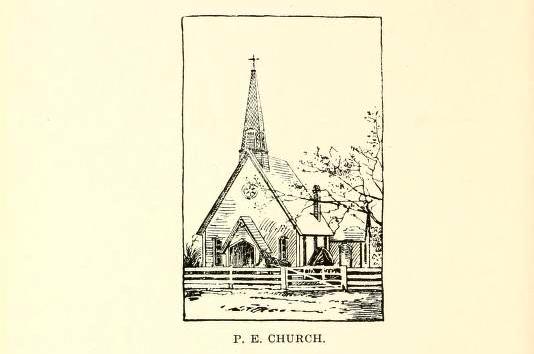
Christ Protestant Episcopal
The little Protestant Episcopal Church in this town was built by Mr.
Samuel H. Fluharty, a contractor, in the fall of 1873 and early
spring of 1874 and dedicated by Bishop Henry C. Lay on
the 30th of April of the latter year, at which service the Rev.
Dr. Theodore Barber, of Cambridge, Revs. James
Mitchell, of Centerville; George F. Beaven, of
Hillsboro; Revs. Hoskins, of East New Market; Watson,
of Kent Island and Dr. Stearns, the rector, were
present. Little change has been made in its appearance either in
interior or exterior since its erection. The picture of it taken
many years ago whilst the fence surrounded the Court House square is a
good one as it now stands minus the fence, which disappeared years ago.
The reorganization of the parish was effected at a meeting held at the
office of the late Judge Russum in
Denton, on the 11th of February, 1870, at which time the following
vestrymen were elected: Dr. John A. McLean, Dr. Charles
E. Tarr, Messrs. William G. Horsey, Edward C. Carter, Philip W. Downes,
George M. Russum and Robert A. Nichols.
The late James B. Steele was secretary
of the meeting. Efforts were then made to have Rev.
George F. Beaven, then rector of St. Paul's Church, Hillsboro, give
a service each Sunday and some services were held in the Court House and
at private residences by Mr. Beaven.
When the Rev. Dr.
Edward J. Stearns became rector very early in the year
1871, a room on Second Street owned by the late John H.
Emerson, was fitted up and used as a chapel. Mr. Stearns
worked indefatigably t secure funds to build a church and with such
success that in Sept., 1873, the site was secured from Col.
J. W. Bryant, and a building committee composed of the rector, Messrs.
William G. Horsey, Charles Stevens, Philip W. Downes and James
B. Steele was appointed. The name given it at
dedication was Christ Church.
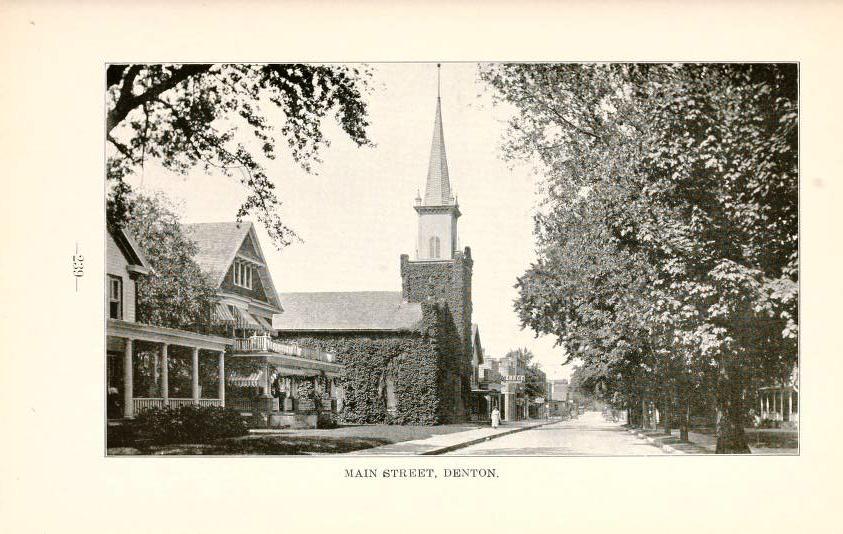
Brethren
About fifteen years ago, a member of the Brethren society who had settled around Denton in considerable numbers built a very substantial concrete block church on South Seventh Street.
Holiness Society
About the same time that the Brethren Church was organized here members of the Holiness Society erected a commodious church building on East Main St.
Roman Catholic
The history of this church may be found under the caption--Early Churches.
ECHOES OF THE PAST
(Lines written
by Miss Rachel B. Satterthwaite and
read before Fidelity Lodge, I.O.G.T., of Denton, on Friday night,
February 20, 1885)
Would you like to hear a story
Of the times of long ago,
Long before this place was Denton
But was Edentown, you know?Long before the bank was thought of,
With its walls of brick and sand,
Currency was then tobacco
All throughout "My Maryland."Offices were not then fought for
Postal clerkships yet unknown,
Neither had railroads been talked of
And much less the telephone.Long before the tall church steeple
Showed to travelers on the road,
That there was a place of meeting
For the worshippers of God.Long before the cruel fire
Rampant ran along Main street,
Causing ruin and destruction,
Making ravages complete.'Twas before the big camp-meeting
Sang hosannas neath the pines
That stood then where now the house stands
Known to all as George Deakyne's.It was there at that camp-meeting,
Truth it is, so I've been told,
First met youth and modest maiden
Now together growing old.To the camp in quaint old fashion
(Then the custom of the land)
Seated on an ox-cart rode she,
While HE walked with shoes in hand.But he now can claim his thousands
With her yet his reigning queen
"Heart and Home" is still their motto
As it always thus has been.While they live to tell their glory
There are those of whom I speak,
Who have answered to the summons
Which calls forth both strong and weak.It was then that sheriff Hughlett,
So the legend comes to us,
Introduced the common sand-bur
As an ornamental grass.And the grass it grew and flourished
Decorating hill and plain
Grieving many an honest farmer
As he garnered in his grain.Well we know our crooked river
Curved around the self same bank
And the shade and herring sported
In the waters of Choptank.That the cold and icy winter
Brought some business on the "flats"
To the men who trapped the otter
And the boys who caught musk rats.In the spring no steamboat's whistle
Echoed through the neighboring wood
But the croak of frog and turtle
To the settler boded good.Then, perhaps, if you had met him,
And inquired for his home,
Quick response, "Pig Point, God bless you,
And from there I'll never roam."But alas! for human nature
Gratitude won't always stay,
And the answer differed later
When the "bilious" held full sway.Summer had its birds and flowers,
And the roses came in June,
Though no "Guide to Floral Culture"
Helped them with their rich perfume.Autumn came with fruits and hunting,
Apples, peaches, grapes and pears,
Chinquapins and ripe persimmons,
Squirrels, partridges and hares.Making this a scene of action
As the seasons went and came,
Bringing with them joy and sorrow,
As to us? Yes, just the same.For we know the happy mother
Clasped her infant to her breast,
Watched him grow to useful manhood,
Ere she laid him down to rest.Or, perchance, she was not happy,
Children sometimes went astray,
Wandered from the path of virtue,
Even as they do today.But we know the Christian mother
Had an answer to her prayer
When she saw the scales true balanced
In the Home that has no care.Yes we know that children prattled,
In those days of long ago;
Know full well that young men courted,
And sometimes a girl said "No."As to who received the mitten,
Or who was the lucky one,
History remaineth silent,
And my story can't go on.
The first school building was situated close to what is now Garey's
canning factory, near the present State road. At that time it was
called Piney school, the name taken from the pine woods, presumably.
The old school house is still standing and is used as part of a dwelling
house in the neighborhood. In 1878 a new school house was built
more nearly the center of the district. It was named Greenlee's
school at first for Arthur John Greenlee who
donated the land, later it was changed to Garey's School as Matthew
Garey was one of the oldest settlers in the district
and owned much land therein.
This district may claim the credit of
having the first court in Caroline County—Melvill's Warehouse. By
a ferry across the river at this point it seems that this neighborhood
was in the direct line of travel from Queenstown near the Chesapeake, at
that time an important trading place and county seat of Queen Anne
County, and Whitelysburg and Dover. Could we but glance back
through these 140 years or more, we could doubtless see this community a
busy one--especially with the growing of tobacco and its preparation for
shipment to England from the warehouse at Melvill's landing nearby.
As early as 1780 some notice in the
land records in the Clerk's Office is given a chapel which then stood by
Ingram's Creek--the early name for Chapel Branch. Perhaps this
building was used later jointly as a church and school for the
community. No doubt some of the well known itinerant ministers
held services in this chapel at various times.
The present church building was
erected in 1879 by the efforts of the local people headed by Thos.
F. and Matthew Garey, one of whom
gave the land, and the other aided in the building.
The original power plant of the
Peninsular Lighting Company was located in this section—the former Garey
Mill site. The mill at this place was in operation before 1800,
being then operated by Col. Matthew Driver, a
prominent man of the time. Somewhat later Col.
Driver maintained a saw mill near where the state road
crosses Chapel Branch.
OAKS
Oaks school (which derived its name from the large oak trees, many, many
years old, standing near the school building) is located about
one-fourth mile from Hobbs, and is the second known building on this
spot. The oak trees referred to above are several feet in diameter
and must be several hundred years old. Who knows but that Indians
were holding pow-wows around these trees when Columbus discovered
America?
In this general section, near the old
Anthony's Mill site, official records show that a school was taught by Andrew
Banning previous to 1793, thereby indicating an early
development of this territory.
Hobbs, a thrifty village of Caroline
County, is situated on the M.D & V. Railway about three miles east of
Denton. The village of Hobbs has about one hundred inhabitants,
one general store, a post-office, from which there is one rural route
for the delivery of mail, also a general factory which is known as the
Hobbs Manufacturing Company, where men, women and children are given
employment in making baskets, crates and boxes for fruits and
vegetables.
Hobbs was named in honor of the late Saulsbury
Hobbs, a prominent and highly esteemed gentleman, owning broad acres
in this section.
There is a church of the Methodist
Protestant denomination, known as Ames Chapel, built in the year 1877,
dedicated in 1878, and named in honor of the Rev.
William C. Ames, the then present pastor. It has quite a large
membership. Ames Chapel is one of four churches of Caroline
Circuit, the other three being Thawley's, Piney and Burrsville.
The parsonage is also located here.
WILLOUGHBY'S
The neighborhood of Willoughby's and Ringgold's Green (the latter a
cross-roads) near the Delaware line, have been known by some of its
inhabitants since Revolutionary times. In this section lived Seth
Evitts, who was a militia officer in our first war with England.
His house, a brick structure, is still standing on the Andersontown
road.
Very early, too, Thomas
Willoughby came into this section and gave the name to
the community which it has retained till this time.
Ringgold's Green probably takes its
name from the constant "greenness" of the swampy region around.
A story is related that near this
cross-roads a fatal tragedy once took place.
Since 1882, the school for this
section has been in the present building, though at least two buildings
were erected earlier in this neighborhood for school purposes.
ANDERSONTOWN
Andersontown was so named, because a certain James
Anderson many years ago owned considerable land and
transacted much business in this vicinity. As early as 1840 this
place which lay at the juncture of two main roads, the one leading from
Greensboro to Hunting Creek (now Linchester), the other being the direct
road from Potter's Landing to Marshy Hope Bridge—had a store, a
blacksmith shop, and one or two dwellings. Later on two stores
were kept busy. Mr. Tilghman Nuttle succeeded
by his sons were prominent merchants of this place for more than a
generation.
Before 1867, the school for this
section seemed to be Meluney's, which was located about a mile away on
the road to Potter's Landing. This building probably not being
large enough for the community, Tilghman Nuttle,
Tilghman Andrew, and William Stevens were July 3, 1867,
named a committee to sell the old building and ground and superintend
the erection of a new building on the lot purchased nearer Andersontown.
A second school house erected on this site was in 1919 burned and the
old Holiness Church nearby purchased, and transformed into the present
school building.
Much of the land in this community
was formerly owned by General William Potter.
LIDEN'S
Though having been moved some distance several times, Liden's school as
indicated elsewhere in this book, dates among the earliest of the
county—probably as far back as 1820 when the buildings of logs stood
near Camp Ground Branch.
Since the establishment of the public
school in 1865, Liden's has been continually on the list and for a
greater part of this time a rather large school.
The name of Liden's is in honor of Shadrach
Liden who as early as 1840 deeded a piece of land for a
site of a church and school. Thus for years the old building was
also used as a place of worship. In 1890 Zebedial
Fountain conveyed a piece of land for a new site and
the present building was erected.
Thawley's Church, now in Hickman, was
originally built in 1884 on a plot of land deeded to the trustees by Zebedial
Fountain, being located near Liden's school, about two miles
southwest from its present site.
Nobletown, the community in which it
was first erected, being greatly in need of a church, several men of
this community, among them Philip and Clement
Noble, James F. Fountain, Willis Liden, Tilghman Meluney, George
Thawley, Zebedial Fountain and others along with Henry
Thawley of Burrsville and assisted by Rev.
A. D. Davis of Denton, erected the building and named
it Davis' Chapel in honor of the Reverend Davis indicated
above. The intention of the builders was to maintain an
independent chapel for a while, at least, but in some way the Wilmington
Conference of the M. E. Church took possession of the building and sent
a minister. Subsequently its name was changed to Thawley's, in
honor of Henry Thawley, and about 1898 the building
was moved to Hickman where it stands at present. The corner stone
which was not moved with the church was recovered in 1919 through the
efforts of the pastor, Rev. G. T. Gehman, and
restored to its proper place.
HICKMAN
The village of Hickman, situated directly on the Maryland-Delaware line,
has been a hamlet for many years, and was originally called Hickmantown
and later abbreviated when a post office was established there.
For years simply as a cross roads,
the coming of the railroad gave it new life and energy until now it has
reached considerable proportions, having a church, school, flour and saw
mill, blacksmith shop, barber shop and an automobile garage.
Its name is in honor of a Mr.
Hickman, who years ago owned considerable property in this
neighborhood.
Until eight years ago, when a public
school was started on the Maryland side, it was necessary for the pupils
to go two miles to Liden's. A joint school by the two states is in
contemplation.
WILLISTON (Potter's Landing)
Potter's Landing, now called Williston, is one of the most historic
settlements of Caroline County. The early history of this place
dates from about 1750 and is described elsewhere in this volume in
connection with the Potter family—the
first known settlers.
During the Revolutionary War this
place served as a depot for collecting supplies for the soldiers and at
the same time, likely served as a drilling place for the militia.
Since the earliest date Potter's Landing has been known as a shipping
center and continued as such until about twenty years ago when the Queen
Anne Railroad brought death to the steamboat traffic from this point.
For some years prior thereto, two steamboats daily left wharves at this
place for Baltimore, carrying passengers and freight.
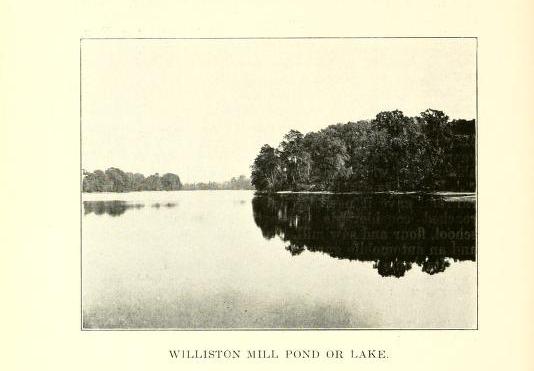
The name of Coquericus Creek (Cokiases Creek) was originally given as
the name of the local branch which supplies the Williston mill today.
The first mill was built much nearer the head of the pond than the
present site and was apparently in operation before 1778 when official
notice of its lease by Nathaniel Potter is
recorded.
General William Potter built
the present milldam or at least widened it considerably, dug out the
mill race and even projected a ship channel to the mill race from the
river by means of which vessels could unload grain and receive milled
goods directly at the mill. The enormous expense of this operation
which only partially succeeded, is said to have financially involved the
projector. After the mill had exchanged hands several times, it
finally became the property of Willard C. Todd, the
present owner, who has greatly improved the property by adding the
latest milling machinery.
General Potter also maintained
a tannery, making leather for the people of this section. Remains
of this old tannery may be seen in the pis which lie at the south of the
mill dam.
So important was this point at one
time that a hotel was built and kept for some years. This building
has since been used as a dwelling.
The Williston church, about a mile
north of the village, was built about forty years ago largely through
the efforts of Elias W. Williamson, a well known
county man of thirty years ago, who resided near this place. After
being furnished with ministers from the Methodist Episcopal Conference
for many years, it became several years ago, under the active control of
the Swedenborgian Church, Rev. J. E. Smith, of
Philadelphia, being the present pastor.
The children of this section went to
Gravelly Branch or Meluney's schools a mile or two away until 1869, when
a teacher for Potter's Landing was appointed by the School Board.
This school seems to have been open rather irregularly till 1877 when Dr.
J. W. Hignutt deeded a piece of land for a school site,
the present building being erected about this place.
The Williston Mill Pond, latterly
known as the "Lake," is directly on the State Highway and is perhaps one
of the most beautiful sheets of inland water on the Eastern Shore.
WILLIAMSON
Midway between Williston and Andersontown is a school called Williamson,
named for Elias Williamson, one of Caroline's
representative men until his death about fifteen years ago. Mr.
Williamson realizing that the community was somewhat
distant from a public school erected a school building and employed a
teacher for the benefit of the children of the neighborhood. A
little later a teacher was provided by the county School Board and after Mr.
Williamson's death the property was purchased by the
Board of Education.
This neighborhood is closely
connected with the Williston community, for formerly much of the land of
both sections was owned by one or more of the Potters.
Pealiquor, a river site nearby (the
Cape May of Caroline) takes its name presumably from the name of the
original tract—Pealicker.
THE BUREAU
Many have inquired the origin of the building commonly called The
Bureau, located on the state road leading south from Williston.
At the close of the Civil War an
effort was made by the Federal government to provide in each section of
the Southern States, a place where religious, educational and civil
instruction could be given to those that had been set free. This
structure—A Freedman's Bureau—was the one provided for this county as
its part of the $1,500 used for such purposes. It is said that the
lumber which was brought up the river for this building was intended to
be delivered at Denton, but was put off lower down by mistake. The
colored people have used the building continuously for both church and
school purposes until 1910, when the school room was declared unfit for
school purposes and a building in Pinetown secured.
